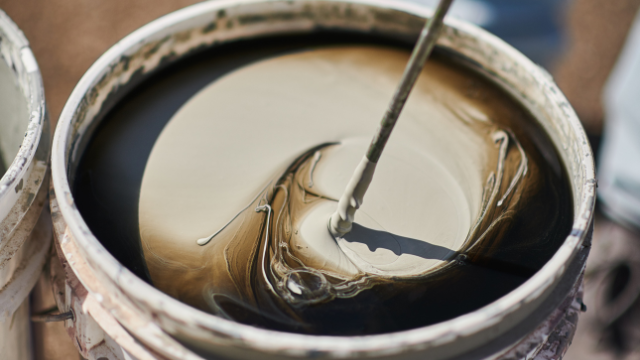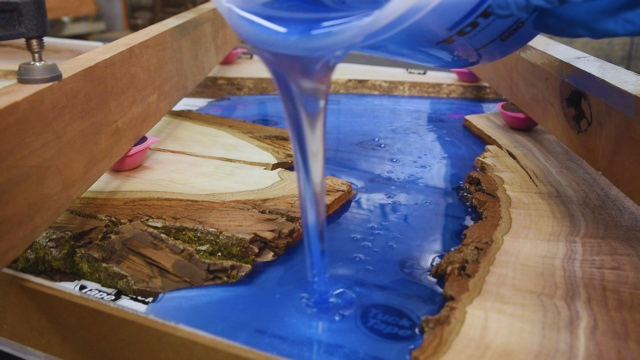Working with epoxies in hot weather
In addition to mixing ratio, temperature is one of the key reasons epoxy projects are successful or not. And it's not just the temperature of the epoxy that matters; it is also the temperature of the surface you are casting on and the ambient temperature of your workroom.
When you mix the resin and hardener components, a reaction occurs that creates heat. How much heat is generated and when it is generated depends on the type of epoxy resin, the speed of the hardener, the volume being mixed, and the temperature. For example, a larger volume with a fast hardener will heat up faster and be hotter than a small volume with a fast hardener.
Any excessive heat in the room or on the surface will affect pot life and cure time and can also affect the mechanical-physical properties of the epoxy cast, so the cast can then be weaker, brittle or yellow if it gets too hot during the cure cycle.
How higher temperatures affect the resin
The best temperature range for working with epoxy is around 18-25 °C, depending on the type you are using. This temperature range is intended for the working environment, resin, wood, hardener and mold. At temperatures above 25 °C, the mixed material heats up faster by releasing heat as it bonds, giving you less time to mix and cast before it sets. Not only will the pot life (the amount of time you can work with the epoxy after mixing the two components) be shortened, but the curing time will also be significantly shortened.
TIPS on how to make decisions and cast epoxy at higher ambient temperatures
- Use a slower hardener if available for the epoxy system you are using. If you have Veropal UV PLUS 130 resin (which has a 100 : 30 mix ratio) which is faster, a version of Veropal UV PLUS 100 (has a different, slower hardener and a 100 : 40 mix ratio). When it is too hot and you want to cast a 5cm layer (the boundary layer for Veropal UV PLUS 130), then you should choose Veropal UV PLUS 100 (or take component A from UV PLUS 130 and mix it with hardener (component B) from the UV PLUS 100 system in ratio 100 : 40 - NOTE: component A is the same for these systems, the systems differ in the hardener and therefore also in the mixing ratio).
- If you want to maintain the recommended temperature and at the same time regulate the air humidity level, use an air conditioner to cool the room.
- Before dispensing, keep the resin and hardener components cold by temporarily placing closed containers in a cold water bath.
- For more heat dissipation and more efficient cooling, mix the resin and hardener components in a wider container that creates a larger surface area. Or mix the ingredients thoroughly in a smaller bowl and place it on ice or in cold water.
 Casting of epoxy resin | Epoxio
Casting of epoxy resin | Epoxio Why high humidity is bad for epoxy resin
You will achieve the best results if the humidity in the environment is below 60 %. Higher humidity means more moisture in the air, which can cause clouding of the surface layer of the epoxy during curing, or micro-crystals of carbonate will form on the surface (especially in faster systems, where in faster hardeners contained one very hygroscopic substance willingly binding water from the air) having such an "icy appearance". Microcrystals are very easy to sand off, but it is extra work and people who encounter it for the first time are unpleasantly surprised. You can sometimes see something like this happening already during hardening, when a shell is formed on the surface, similar to a shell when hot milk cools. You will usually see this after the resin has cured. It is therefore a good idea to monitor the temperature and humidity during the process.
How to get the best results when curing epoxy in hot weather
- It is important to maintain a stable room temperature and humidity during the curing process. The temperature should not exceed 25 °C and ideally the humidity should be below 60 %. However, always check the specified temperatures for the product you are using for best results.
- Use an air conditioner to keep the room within the recommended temperature and humidity range. Be careful not to cool the room too much, otherwise the curing time will be extended.
- If you use air conditioners or fans to cool the room, be careful not to create too much of a flow to prevent dust from settling on the surface.
If you have any questions regarding working with our products in warmer temperature conditions, or conversely in colder conditions, contact our friendly Epoxio.cz technical support team at +420 737 108 685 for answers. Do not hesitate to read other interesting articles, instructions, advice and tips on our Epoxio Academy.
Share your creative projects by tagging us on Instagram with @epoxio, #epoxio and #myepoxio and on Facebook epoxio.cz - we can't wait to see what you do!






